Folk, calligraphy paintings brighten Vietnam’s Tet
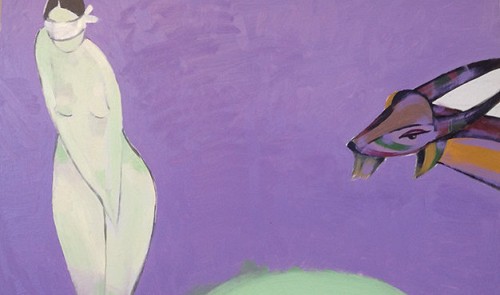
Apart from shopping for food, clothing items and floral embellishments for the upcoming Tet, many also choose to buy calligraphical works and Tet paintings.
Calligraphical works are those featuring stylized words in Vietnamese, Chinese and even English or any other language that one’s heart desires.
The words, which are mostly with educational and literary meanings, are written in a special kind of ink and with a brush.
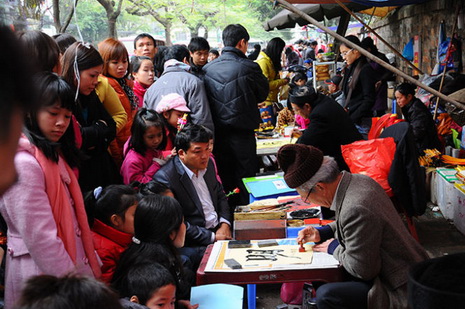
People are seen flocking for "ong do" (calligrapher)'s calligraphical words in Hanoi for the 2015 Tet (Lunar New Year). Photo: Tuoi Tre.
Those trained to write the words are called “ong do” (calligrapher,) who are usually senior in age and dressed in male “ao dai” (traditional long gown) and headdress. A number of “ong do” are in their 20s or 30s, however.
People typically come to see “ong do” before, during and after Tet and have them write the calligraphized words on different kinds of paper in return for money.
Tet begins on February 19 this year, with festive activities lingering on around one week after that.
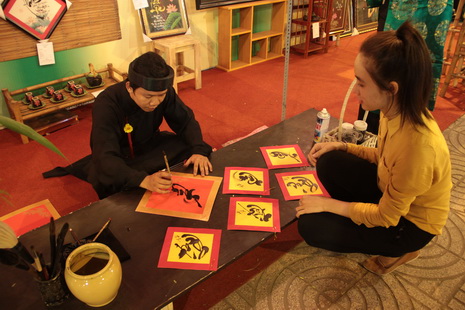
A young "ong do" (calligrapher) is pictured writing calligraphized words with a brush at an ongoing 2015 Tet fair in Ho Chi Minh City. Photo:Tuoi Tre.
“Ong do” generally sat on the sidewalk in some streets in Hanoi, but this year around 200 ones will gather in 100 tents erected inside Van Mieu Quoc Tu Giam, which is believed to be the country’s first university.
Only those who pass a qualifying test are eligible to join the activity, which will be strictly monitored by the organizer to ensure no overcharge or rip-off.
The event is set to run from the 20th of the current lunar year to the 15th of the lunar new year’s first month, or February 8 to March 5.
A similar festival is also running at 116 Nguyen Du in Ho Chi Minh City’s District 1 until February 18, or the Lunar New Year’s Eve.
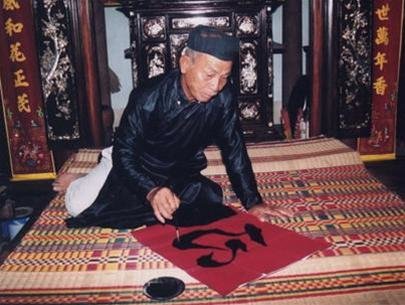
An esteemed "ong do" is seen writing his first calligraphical word for the Lunar New Year in this Tuoi Tre file photo.
This festival features 15 stalls which offer exhibitions on calligraphical works, exchange activities as well as performances of UNESCO-recognized “don ca tai tu” (southern folk music), and sell handicraft items made by physically-challenged people.
Tet paintings
Another refined hobby is collecting and hanging Tet-themed paintings.
Tet paintings, which have long been a fixture of locals’ celebration of the holiday, are typically in flamboyant colors and feature diverse topic matters in dexterous brush strokes.
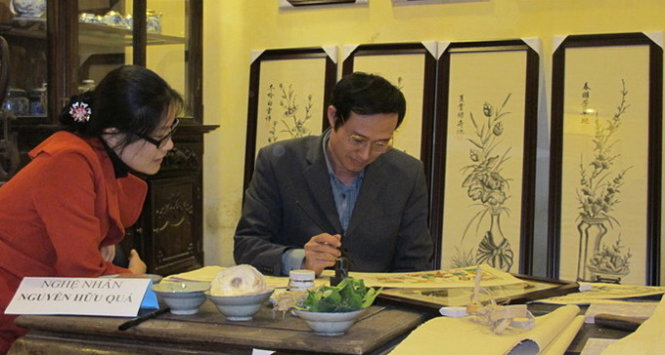
A revered artisan (black suit) is seen creating a Tet painting at a 2014 Tet art fair in Hanoi. Photo: Tuoi Tre.
Tasteful paintings, including painted loudspeakers, are also sought after for the Tet holiday.
Painted speakers generally feature canvases on the front which are suitable for painting or printing photos on.
Tet paintings vary in price considerably, ranging from a few to several hundreds of US dollars. Thus, people from all walks of life can obtain a painting for their Tet celebration.
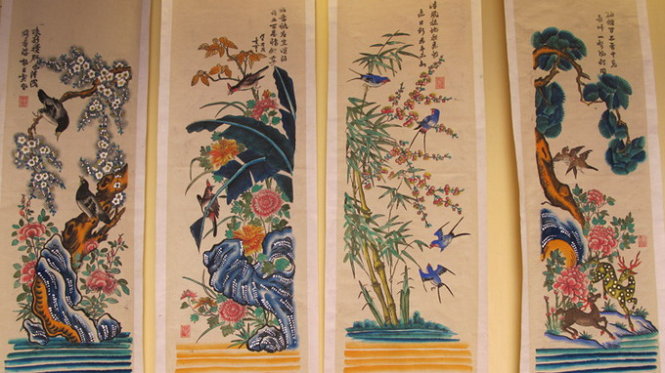
A gorgeous signature Tet painting which depicts the rustic landscape in four seasons in a year. Photo: Tuoi Tre.
A few days prior to Tet, people in the countryside habitually remove their old paintings and hang new ones to “bid farewell to old things and embrace the new.”
According to archival documents, the country boasts many folk painting villages and schools.
The most long-standing and popular are Dong Ho woodblocks and Hang Trong and Kim Hoang paintings from the northern province of Bac Ninh and Hanoi, and Nam Hoanh and Sinh village paintings from Nghe An and Thua Thien- Hue provinces in the central region.
Though all are symbolic of people’s wishes for good luck, longevity, wealth, and prosperity in the lunar new year, each school of folk paintings has its own appeal and clientele.
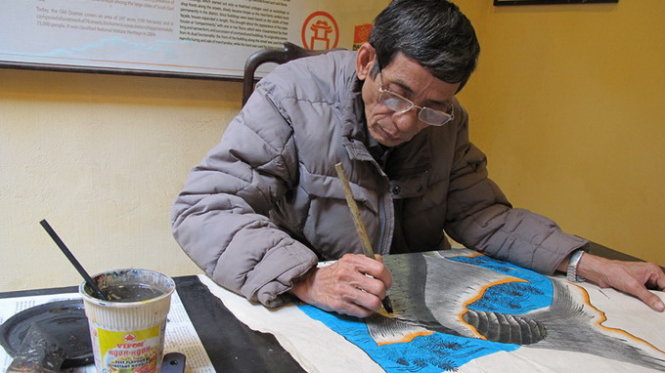
A seasoned veteran is seen creating a Hang Trong Tet painting at the 2014 Tet art fair in Hanoi. Photo: Tuoi Tre.
For instance, Dong Ho woodblocks, originating from Dong Ho village in Bac Ninh province, are simple and rustic and are thus usually preferred by working people and those in the countryside.
Using the traditional “diep” paper and colors derived from nature, craftsmen print pictures of different themes from good luck wishes and historical figures to everyday activities and folk allegories.
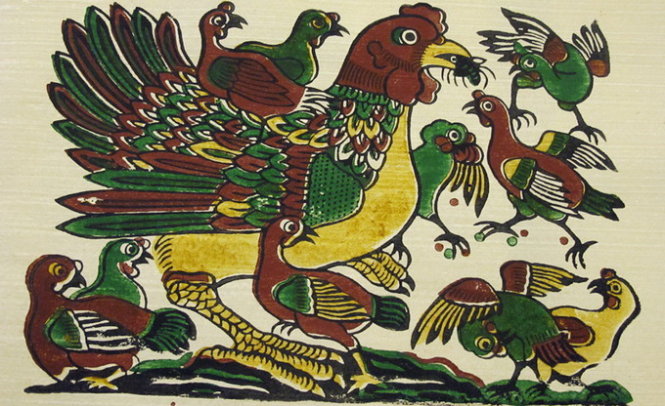
A hallmark Dong Ho folk woodblock. Photo: Tuoi Tre.
By comparison, Hang Trong paintings are more elegant and stylish and are thus more popular among educated and well-off city-dwellers.
Folk paintings created by artisans in Sinh Village, located on the banks of the province’s hallmark Huong (Perfume) River, bear strong resemblances to Dong Ho and Hang Trong folk woodblocks.
Sinh Village woodblocks’ unmistable charms are derived from their vivid colors and images, which make the paintings stand out and differ from one another.
Unlike Dong Ho paintings, which have only four or five principal colors, Sinh Village woodblocks are diversely colored.
The colors are mostly created from natural elements, including leaves, seeds, ash and brick powder, which are skillfully blended to create an array of colors.
Artisans also take great pains to obtain a special type of oyster, with gaudy colors and a thin shell.
The shells are grated into a fine powder, which is then mixed with glue.
The mixture is then applied twice onto “do” paper, a traditional type of paper, to create “diep” paper.
Sinh Village’s paintings also differ from its Dong Ho counterpart in its stress on Hue people’s spiritual meaning.
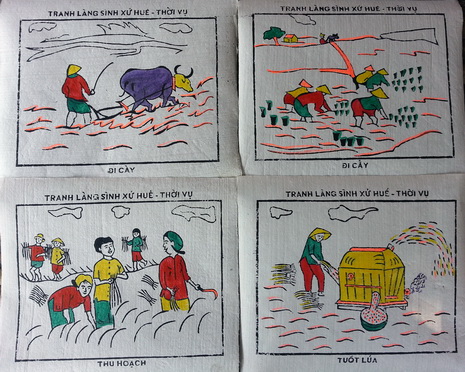
Four new designs of Sinh Village's paintings for the 2015 Tet painting market. Photo: Tuoi Tre.
To better promote and sell the paintings to tourists, seasoned artisan Ky Huu Phuoc has diversified the content of his woodblocks to include new themes such as folk games, daily activities, and landscape.
Four new designs debuted earlier this month.
Phuoc has also created bamboo pipes which he rolls the paintings into, thus enhancing the durability, mobility and appeal of his works.
Along with landscape, items and flowers, Tet paintings also depict the animal zodiac sign of the Lunar New Year.
As this year’s sign is the Goat, paintings on stylized goats are expected to be in high demand.
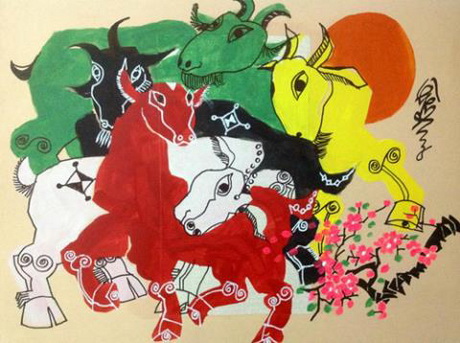
A Tet painting, created by Vietnamese artist Le Tri Dung, features stylized goats.
They can also feature landscape, flowers, goats and calligraphy at the same time.
Days before Tet, such paintings are displayed for sale in country markets or on city streets, and draw quite many shoppers and window shoppers as well.
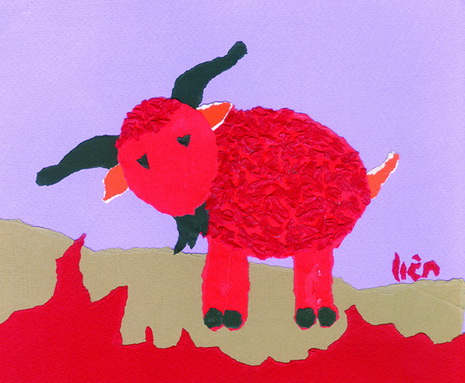
A goat is depicted in one of Vietnamese artist Hoang Thi Phuong Lien's works.
What the stars mean:
★ Poor ★ ★ Promising ★★★ Good ★★★★ Very good ★★★★★ Exceptional
Latest News
More News
- Free tickets, Lunar New Year promotions on offer at Vietjet Mega Livestream (November 26, 2025 | 15:32)
- UNIQLO unveils upgraded heat-retention wear at Hanoi event (October 26, 2025 | 10:00)
- Vietnam named among world’s top four culinary destinations (October 24, 2025 | 17:09)
- Vietnam and Denmark strengthen dialogue on sustainable fashion (October 20, 2025 | 09:11)
- Fusion rolls out special initiatives to celebrate Vietnamese Women’s Day (October 17, 2025 | 20:00)
- Showcase AC 2025 set to light up Hanoi stage (September 12, 2025 | 18:06)
- Hotel Indigo Saigon The City hosts event to reimagine city’s beloved alleyways (July 23, 2025 | 17:04)
- UNIQLO’s sustainability strategy behind the brand's global growth (June 23, 2025 | 15:42)
- Vietnam International Travel Mart 2025 kicks-off in Hanoi (April 10, 2025 | 17:50)
- Phu Quoc named as one of Asia's 'Best Islands' (March 13, 2025 | 10:24)

















 Mobile Version
Mobile Version